2004 NISSAN TERRANO low beam
[x] Cancel search: low beamPage 161 of 1833

3) Using rod with outer diameter of 30 mm (1.18 in), press pistonpins out.
11. Remove lower cylinder block.
I The lower cylinder block is the lower part of the cylinder block,
which works as the main bearing cap (beam) and oil pan
mounting face.
1) Remove mounting bolts for engine sub-attachment shown by arrows in the figure.
2) Loosen and remove mounting bolts in the reverse order shown in the figure.
3) Insert flat-bladed screwdriver into 5 locations shown by arrows in the figure. Lift lower cylinder block evenly, and remove liquid
gasket.
CAUTION:
Prevent mating faces from being damaged.
4) When removing lower cylinder block, use slot to prevent dowel pin from interfering with engine sub-attachment.
I No part No. is given to lower cylinder block, because it is
machined with the cylinder block.
12. Remove crankshaft.
13. Remove main bearings and thrust bearings from cylinder block and lower cylinder block.
CAUTION:
Check mounting positions. Keep them to avoid confusion.
FEM090
FEM091
FEM092
FEM093
CYLINDER BLOCKZD
Disassembly (Cont'd)
EM-70
http://vnx.su/
Page 1524 of 1833
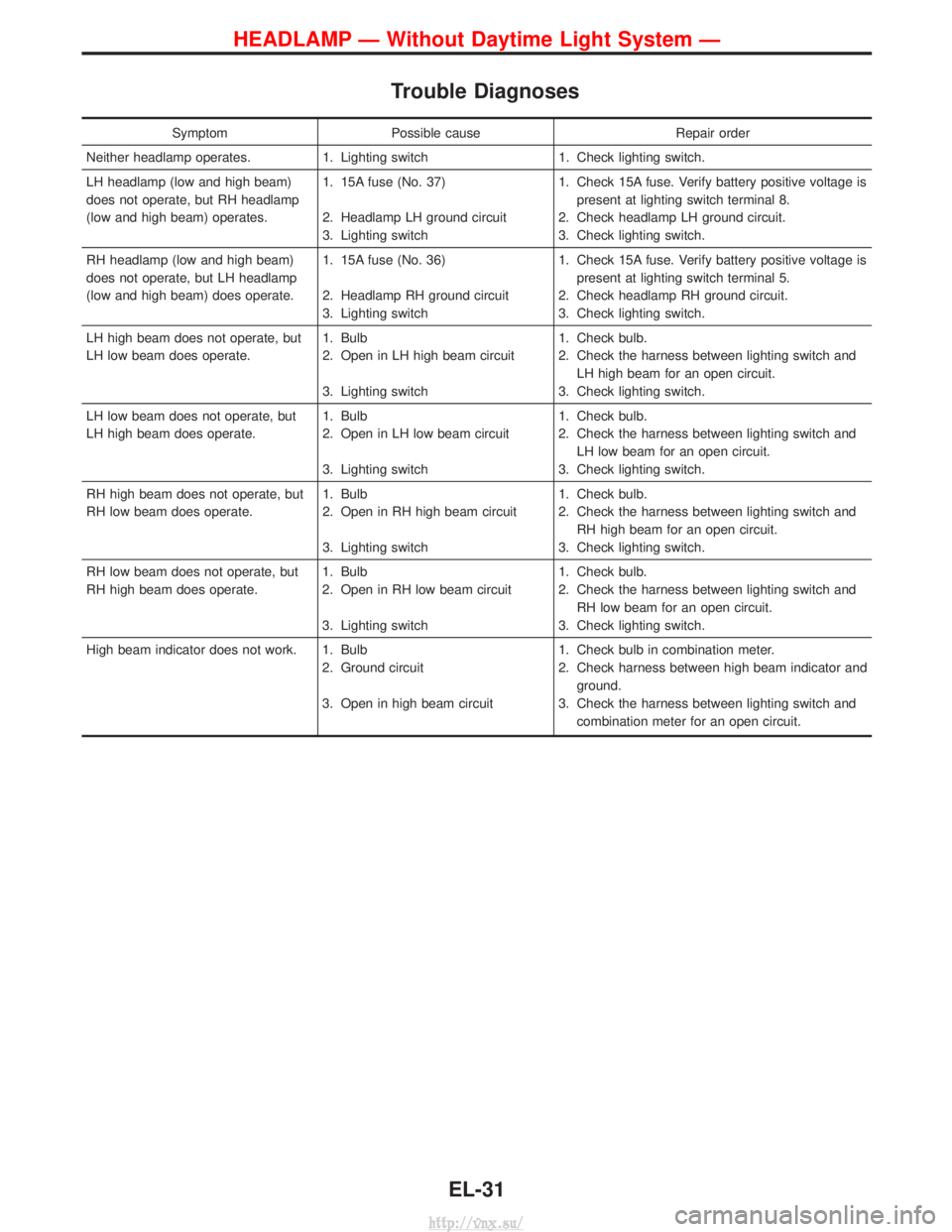
Trouble Diagnoses
SymptomPossible cause Repair order
Neither headlamp operates. 1. Lighting switch 1. Check lighting switch.
LH headlamp (low and high beam)
does not operate, but RH headlamp
(low and high beam) operates. 1. 15A fuse (No. 37)
2. Headlamp LH ground circuit
3. Lighting switch1. Check 15A fuse. Verify battery positive voltage is
present at lighting switch terminal 8.
2. Check headlamp LH ground circuit.
3. Check lighting switch.
RH headlamp (low and high beam)
does not operate, but LH headlamp
(low and high beam) does operate. 1. 15A fuse (No. 36)
2. Headlamp RH ground circuit
3. Lighting switch1. Check 15A fuse. Verify battery positive voltage is
present at lighting switch terminal 5.
2. Check headlamp RH ground circuit.
3. Check lighting switch.
LH high beam does not operate, but
LH low beam does operate. 1. Bulb
2. Open in LH high beam circuit
3. Lighting switch1. Check bulb.
2. Check the harness between lighting switch and
LH high beam for an open circuit.
3. Check lighting switch.
LH low beam does not operate, but
LH high beam does operate. 1. Bulb
2. Open in LH low beam circuit
3. Lighting switch1. Check bulb.
2. Check the harness between lighting switch and
LH low beam for an open circuit.
3. Check lighting switch.
RH high beam does not operate, but
RH low beam does operate. 1. Bulb
2. Open in RH high beam circuit
3. Lighting switch1. Check bulb.
2. Check the harness between lighting switch and
RH high beam for an open circuit.
3. Check lighting switch.
RH low beam does not operate, but
RH high beam does operate. 1. Bulb
2. Open in RH low beam circuit
3. Lighting switch1. Check bulb.
2. Check the harness between lighting switch and
RH low beam for an open circuit.
3. Check lighting switch.
High beam indicator does not work. 1. Bulb 2. Ground circuit
3. Open in high beam circuit1. Check bulb in combination meter.
2. Check harness between high beam indicator and
ground.
3. Check the harness between lighting switch and combination meter for an open circuit.
HEADLAMP Ð Without Daytime Light System Ð
EL-31
http://vnx.su/
Page 1525 of 1833
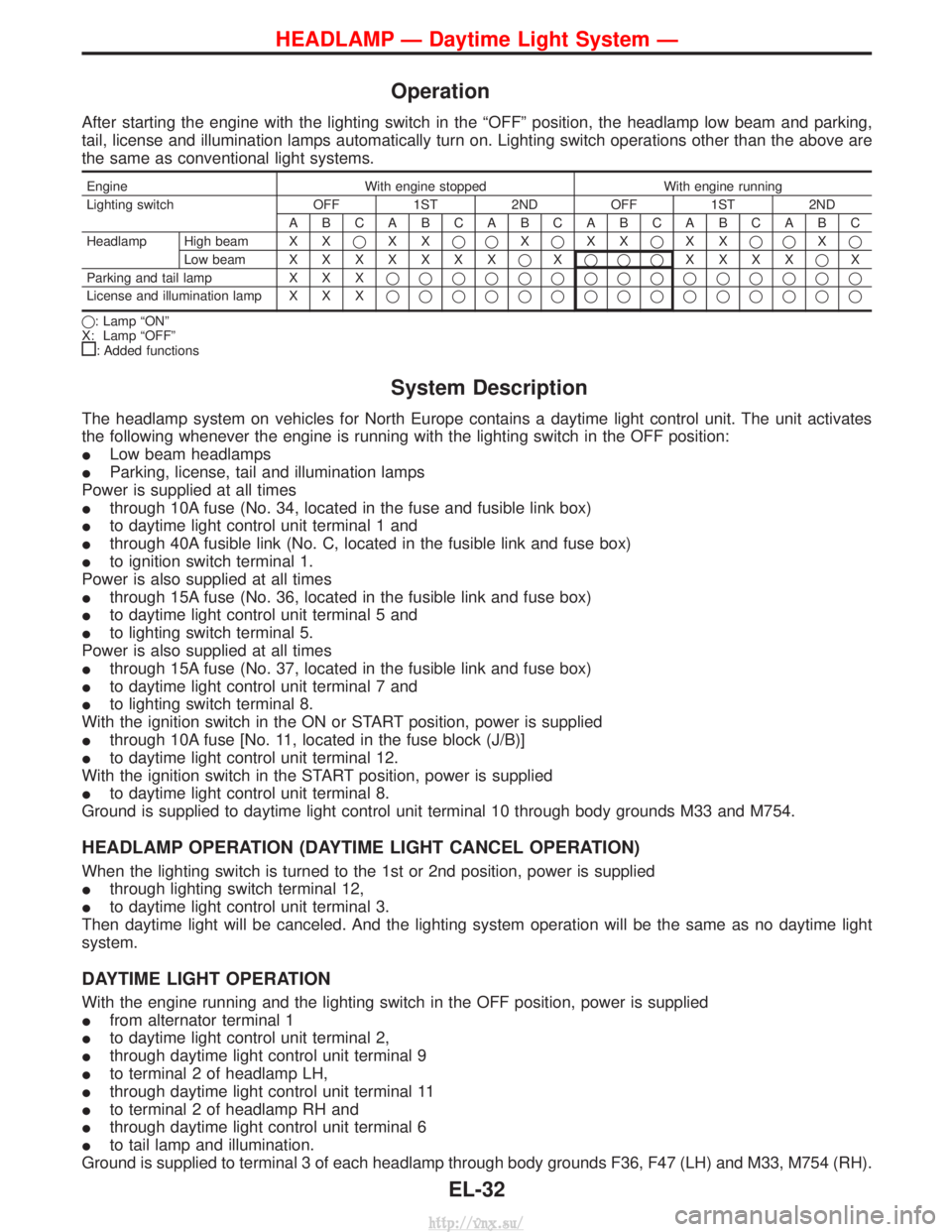
Operation
After starting the engine with the lighting switch in the ªOFFº position, the headlamp low beam and parking,
tail, license and illumination lamps automatically turn on. Lighting switch operations other than the above are
the same as conventional light systems.
EngineWith engine stopped With engine running
Lighting switch OFF 1ST 2ND OFF 1ST 2ND ABCABCABCABCABCABC
Headlamp High beam X X qXX qq Xq XX qXX qq Xq
Low beam XXXXXXX qXqqq XXXX qX
Parking and tail lamp X X Xqqqqqqqqqqqqqqq
License and illumination lamp X X X qqqqqqqqqqqqqqq
q: Lamp ªONº
X: Lamp ªOFFº
: Added functions
System Description
The headlamp system on vehicles for North Europe contains a daytime light control unit. The unit activates
the following whenever the engine is running with the lighting switch in the OFF position:
I Low beam headlamps
I Parking, license, tail and illumination lamps
Power is supplied at all times
I through 10A fuse (No. 34, located in the fuse and fusible link box)
I to daytime light control unit terminal 1 and
I through 40A fusible link (No. C, located in the fusible link and fuse box)
I to ignition switch terminal 1.
Power is also supplied at all times
I through 15A fuse (No. 36, located in the fusible link and fuse box)
I to daytime light control unit terminal 5 and
I to lighting switch terminal 5.
Power is also supplied at all times
I through 15A fuse (No. 37, located in the fusible link and fuse box)
I to daytime light control unit terminal 7 and
I to lighting switch terminal 8.
With the ignition switch in the ON or START position, power is supplied
I through 10A fuse [No. 11, located in the fuse block (J/B)]
I to daytime light control unit terminal 12.
With the ignition switch in the START position, power is supplied
I to daytime light control unit terminal 8.
Ground is supplied to daytime light control unit terminal 10 through body grounds M33 and M754.
HEADLAMP OPERATION (DAYTIME LIGHT CANCEL OPERATION)
When the lighting switch is turned to the 1st or 2nd position, power is supplied
I through lighting switch terminal 12,
I to daytime light control unit terminal 3.
Then daytime light will be canceled. And the lighting system operation will be the same as no daytime light
system.
DAYTIME LIGHT OPERATION
With the engine running and the lighting switch in the OFF position, power is supplied
I from alternator terminal 1
I to daytime light control unit terminal 2,
I through daytime light control unit terminal 9
I to terminal 2 of headlamp LH,
I through daytime light control unit terminal 11
I to terminal 2 of headlamp RH and
I through daytime light control unit terminal 6
I to tail lamp and illumination.
Ground is supplied to terminal 3 of each headlamp through body grounds F36, F47 (LH) and M33, M754 (RH).
HEADLAMP Ð Daytime Light System Ð
EL-32
http://vnx.su/
Page 1540 of 1833
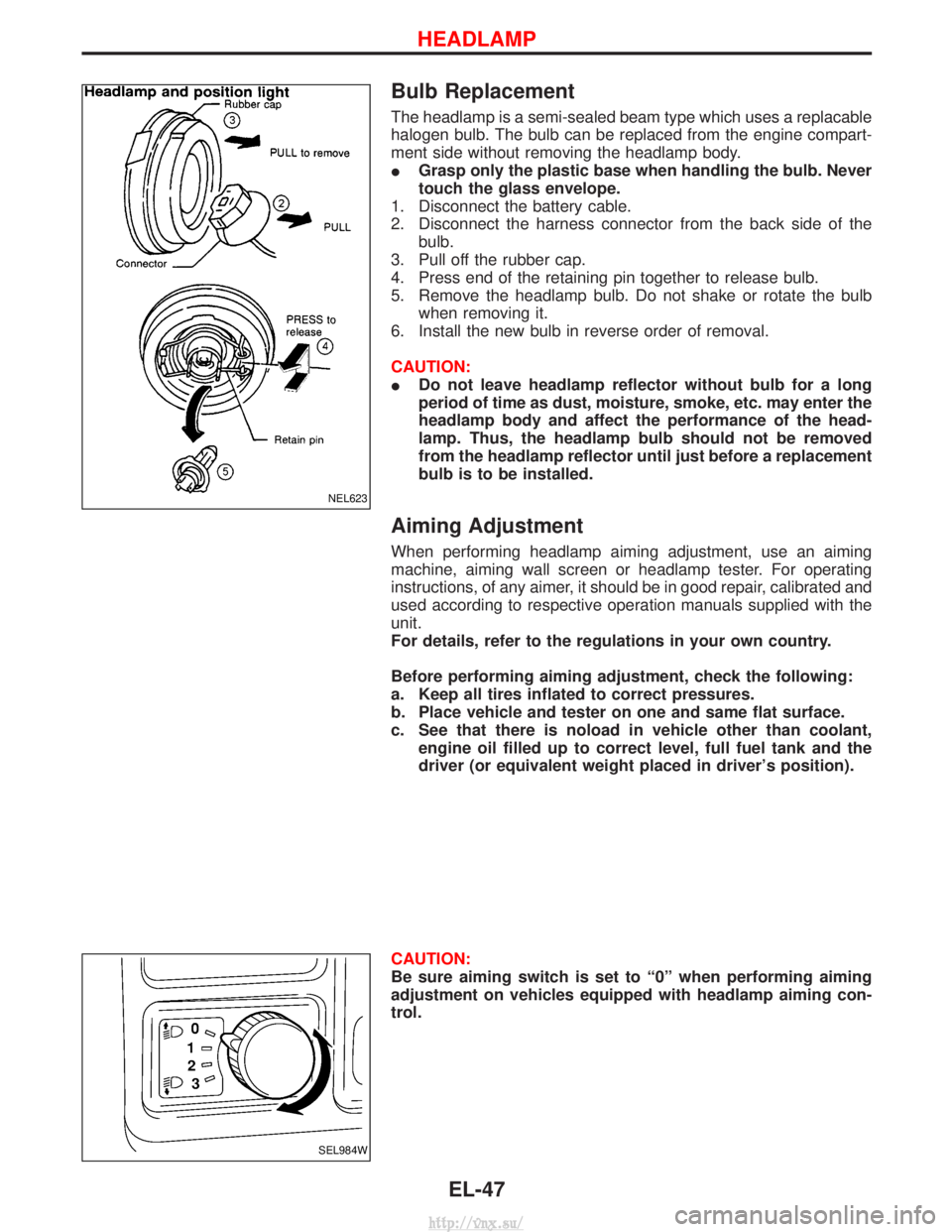
Bulb Replacement
The headlamp is a semi-sealed beam type which uses a replacable
halogen bulb. The bulb can be replaced from the engine compart-
ment side without removing the headlamp body.
IGrasp only the plastic base when handling the bulb. Never
touch the glass envelope.
1. Disconnect the battery cable.
2. Disconnect the harness connector from the back side of the bulb.
3. Pull off the rubber cap.
4. Press end of the retaining pin together to release bulb.
5. Remove the headlamp bulb. Do not shake or rotate the bulb when removing it.
6. Install the new bulb in reverse order of removal.
CAUTION:
I Do not leave headlamp reflector without bulb for a long
period of time as dust, moisture, smoke, etc. may enter the
headlamp body and affect the performance of the head-
lamp. Thus, the headlamp bulb should not be removed
from the headlamp reflector until just before a replacement
bulb is to be installed.
Aiming Adjustment
When performing headlamp aiming adjustment, use an aiming
machine, aiming wall screen or headlamp tester. For operating
instructions, of any aimer, it should be in good repair, calibrated and
used according to respective operation manuals supplied with the
unit.
For details, refer to the regulations in your own country.
Before performing aiming adjustment, check the following:
a. Keep all tires inflated to correct pressures.
b. Place vehicle and tester on one and same flat surface.
c. See that there is noload in vehicle other than coolant,
engine oil filled up to correct level, full fuel tank and the
driver (or equivalent weight placed in driver's position).
CAUTION:
Be sure aiming switch is set to ª0º when performing aiming
adjustment on vehicles equipped with headlamp aiming con-
trol.
NEL623
SEL984W
HEADLAMP
EL-47
http://vnx.su/
Page 1541 of 1833
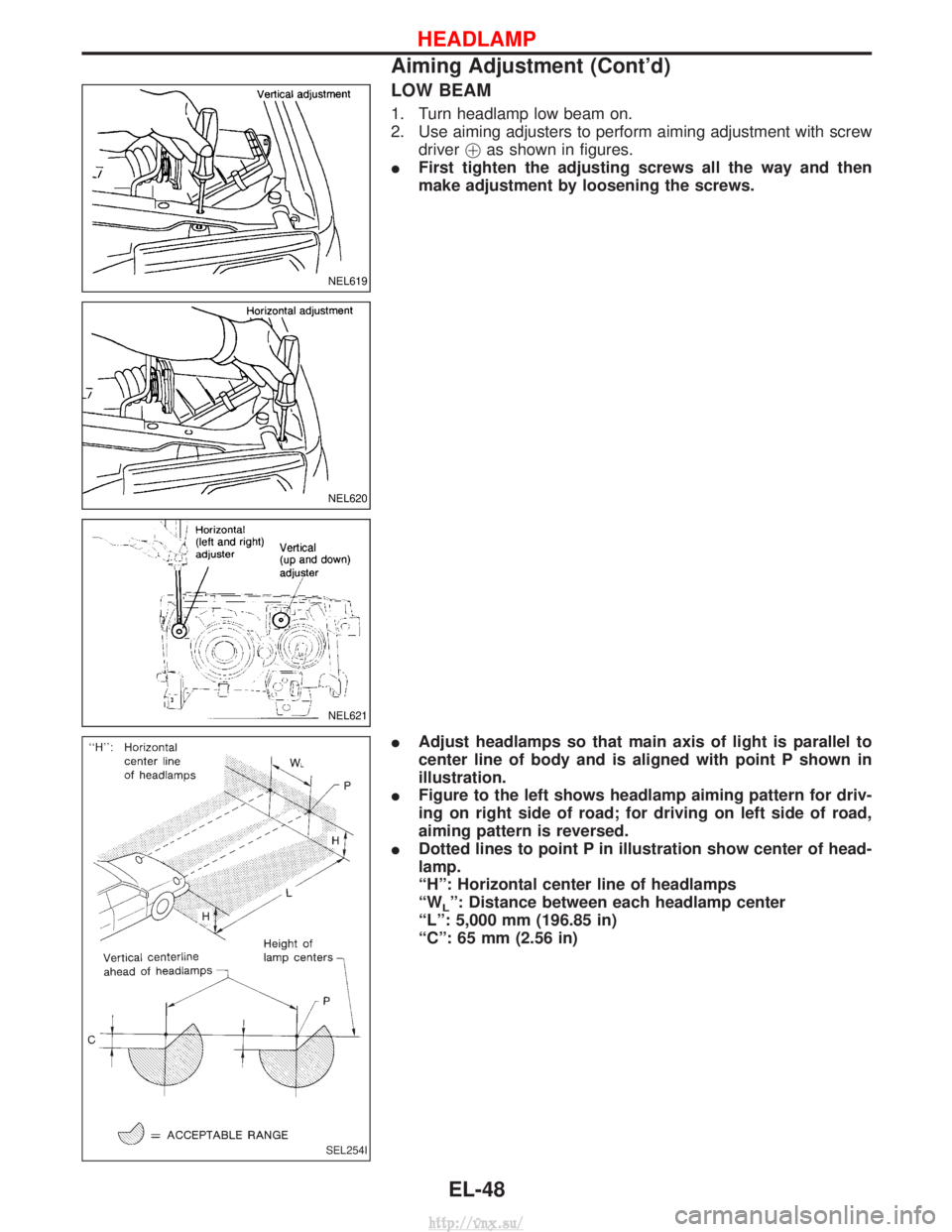
LOW BEAM
1. Turn headlamp low beam on.
2. Use aiming adjusters to perform aiming adjustment with screwdriver !as shown in figures.
I First tighten the adjusting screws all the way and then
make adjustment by loosening the screws.
I Adjust headlamps so that main axis of light is parallel to
center line of body and is aligned with point P shown in
illustration.
I Figure to the left shows headlamp aiming pattern for driv-
ing on right side of road; for driving on left side of road,
aiming pattern is reversed.
I Dotted lines to point P in illustration show center of head-
lamp.
ªHº: Horizontal center line of headlamps
ªW
Lº: Distance between each headlamp center
ªLº: 5,000 mm (196.85 in)
ªCº: 65 mm (2.56 in)
NEL619
NEL620
NEL621
SEL254I
HEADLAMP
Aiming Adjustment (Cont'd)
EL-48
http://vnx.su/
Page 1550 of 1833
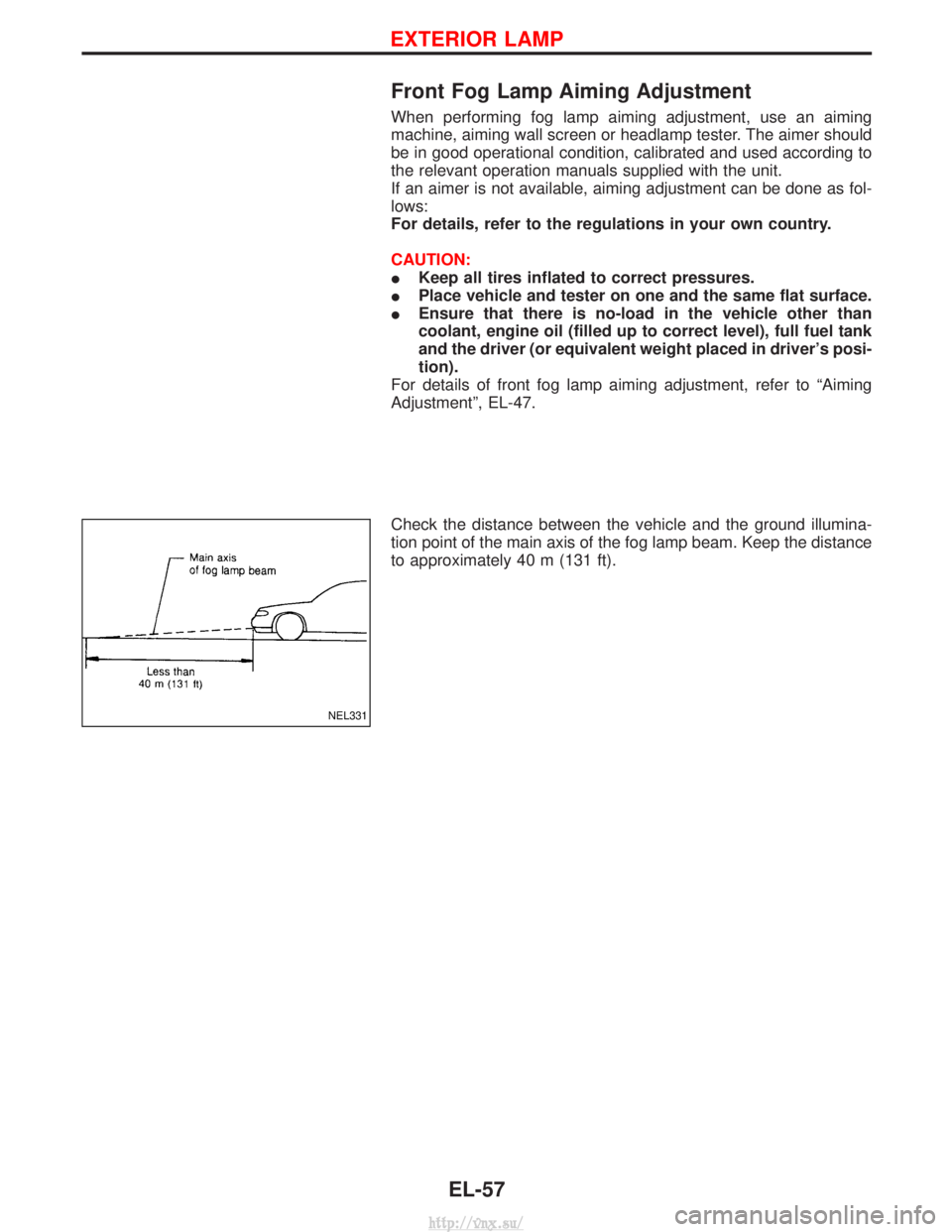
Front Fog Lamp Aiming Adjustment
When performing fog lamp aiming adjustment, use an aiming
machine, aiming wall screen or headlamp tester. The aimer should
be in good operational condition, calibrated and used according to
the relevant operation manuals supplied with the unit.
If an aimer is not available, aiming adjustment can be done as fol-
lows:
For details, refer to the regulations in your own country.
CAUTION:
IKeep all tires inflated to correct pressures.
I Place vehicle and tester on one and the same flat surface.
I Ensure that there is no-load in the vehicle other than
coolant, engine oil (filled up to correct level), full fuel tank
and the driver (or equivalent weight placed in driver's posi-
tion).
For details of front fog lamp aiming adjustment, refer to ªAiming
Adjustmentº, EL-47.
Check the distance between the vehicle and the ground illumina-
tion point of the main axis of the fog lamp beam. Keep the distance
to approximately 40 m (131 ft).
NEL331
EXTERIOR LAMP
EL-57
http://vnx.su/